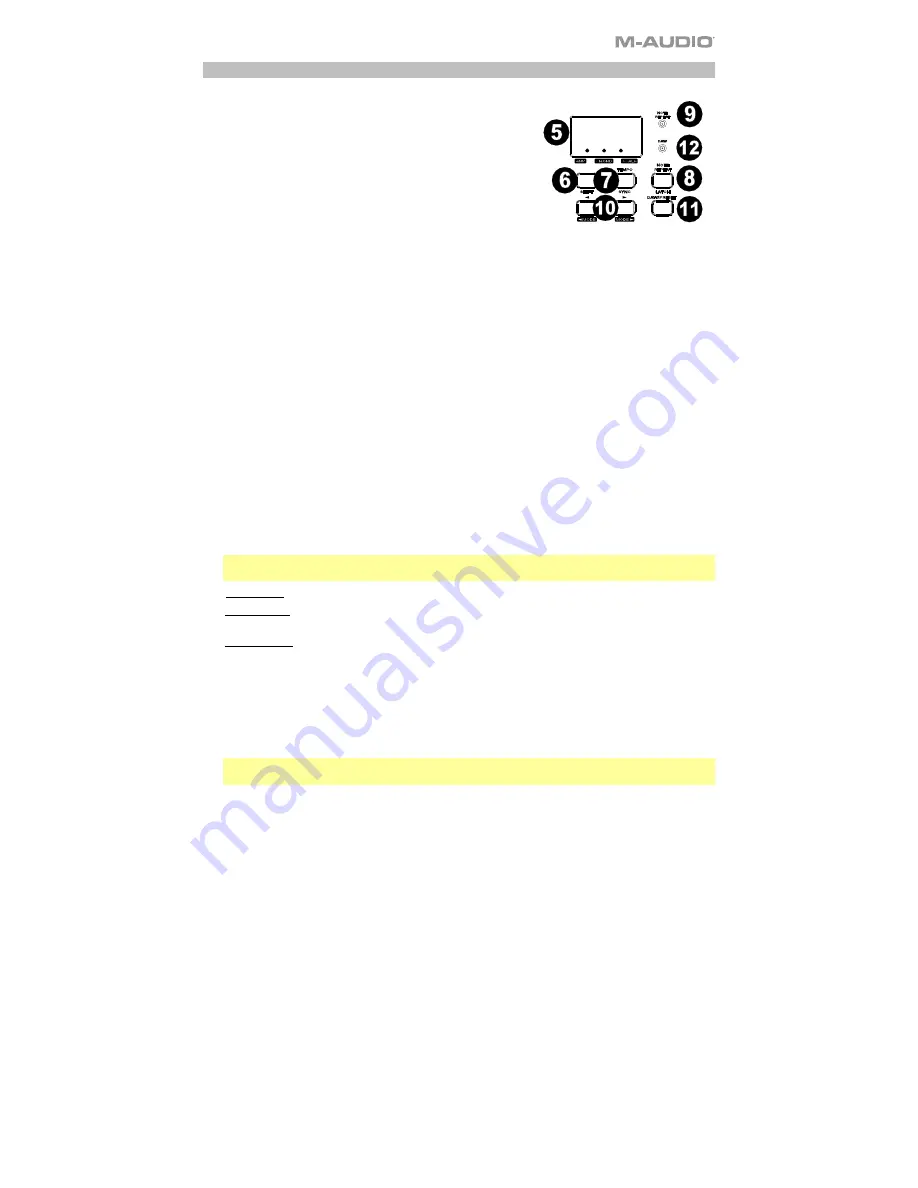
13
Central Functions
5.
Display:
The
Oxygen 49 features a 3-digit LED display
providing visual information regarding current operation,
programing, and controller status.
The 3 dot LEDs on the Display correspond to one of the 4
available modes that is active: ARP, ARP Latch, Smart
Chord, and Smart Scale.
•
ARP:
LED is lit when ARP mode is active.
LED flashes when ARP Latch mode is active.
•
CHORD:
LED is lit when Smart Chord mode is
active.
•
SCALE:
LED is lit when Smart Scale mode is active.
6.
SHIFT:
Hold the
SHIFT
button while moving or pressing controls or buttons on the keyboard to
access their secondary functions.
7.
TEMPO:
Tap this button to set Oxygen 49’s tempo. Press and hold this button and use the
<
and
>
buttons to make incremental changes to the tempo.
SYNC:
Press and hold
SHIFT
and the
TEMPO
button to access the
SYNC
feature, allowing the
keyboard
to be synced to your DAWs Time Clock messages (Tempo).
The tempo setting affects the keyboard’s arpeggiator and note repeat functions.
8.
NOTE REPEAT:
Press this button to activate the note repeat function for the
Pads
.
LATCH:
To latch the note repeat function, hold
SHIFT
and then press this button.
While
Note Repeat
is active hold
SHIFT
and press the
Time Division
keys to change the current
Time Division
setting of the
Arpeggiator
and pad
Note Repeat
.
9.
NOTE REPEAT (LED):
This LED will be lit solid when Note Repeat is active.
10.
<
,
>:
The
<
and
>
buttons will select presets when in Preset mode.
< MODE, MODE >:
When
SHIFT
is held and one of these buttons is pressed, the active mode
will change (ARP, ARP Latch, Smart Chord, or Smart Scale).
To turn on or off the currently active mode, press the
<
and
>
buttons simultaneously. For
example, if Smart Scale is active, pressing the
<
and
>
buttons simultaneously
will deactivate
Smart Scale mode and return the keybed to its normal functionality.
Note:
Depending on what mode the keyboard is currently in the buttons’ functionality will
change.
DAW Mode: In DAW mode,
<
and
>
will scroll through track banks.
Preset Mode: In Preset Mode, the
<
and
>
buttons will scroll through presets. In Edit Mode, they
will cycle through the currently selected editable control.
Note Repeat: When Note Repeat is active the < and > buttons will scroll up and down through
time division settings.
11.
DAW / PRESET:
When this button is pressed, it will activate the keyboard’s Preset or DAW
functionality on the faders, knobs, button, and pads.
When DAW mode is active, controls (Faders, Fader buttons, < and >, pads, and knobs) will send
Mackie, Mackie/HUI, or MIDI CC messages, depending on which DAW is selected.
When Preset mode is active, Preset select will latch on for you to use the
<
and
>
buttons to
select from a list of Virtual Instrument presets.
IMPORTANT:
To change what DAW is currently selected, press and hold the
SHIFT
button and
the
DAW/PRESET
button.
•
NC1:
Mackie 1: Will send standard Mackie messages. Mackie control is typically used for
DAWs like Cubase, Studio One, Logic, and Reaper.
•
NC2:
Mackie 2. Will send standard Mackie messages, but with higher resolution for the pan
pots. If your DAW's pan isn't able to do a full sweep of the pan pot, use Mackie 2. Mackie
control is typically used for DAWs like Cubase, Studio One, Logic, and Reaper.
126
Summary of Contents for oxygen25
Page 1: ...User Guide English 2 31 Appendix English 32 34...
Page 35: ...35...
Page 36: ...m audio com Manual Version 1 0...




























